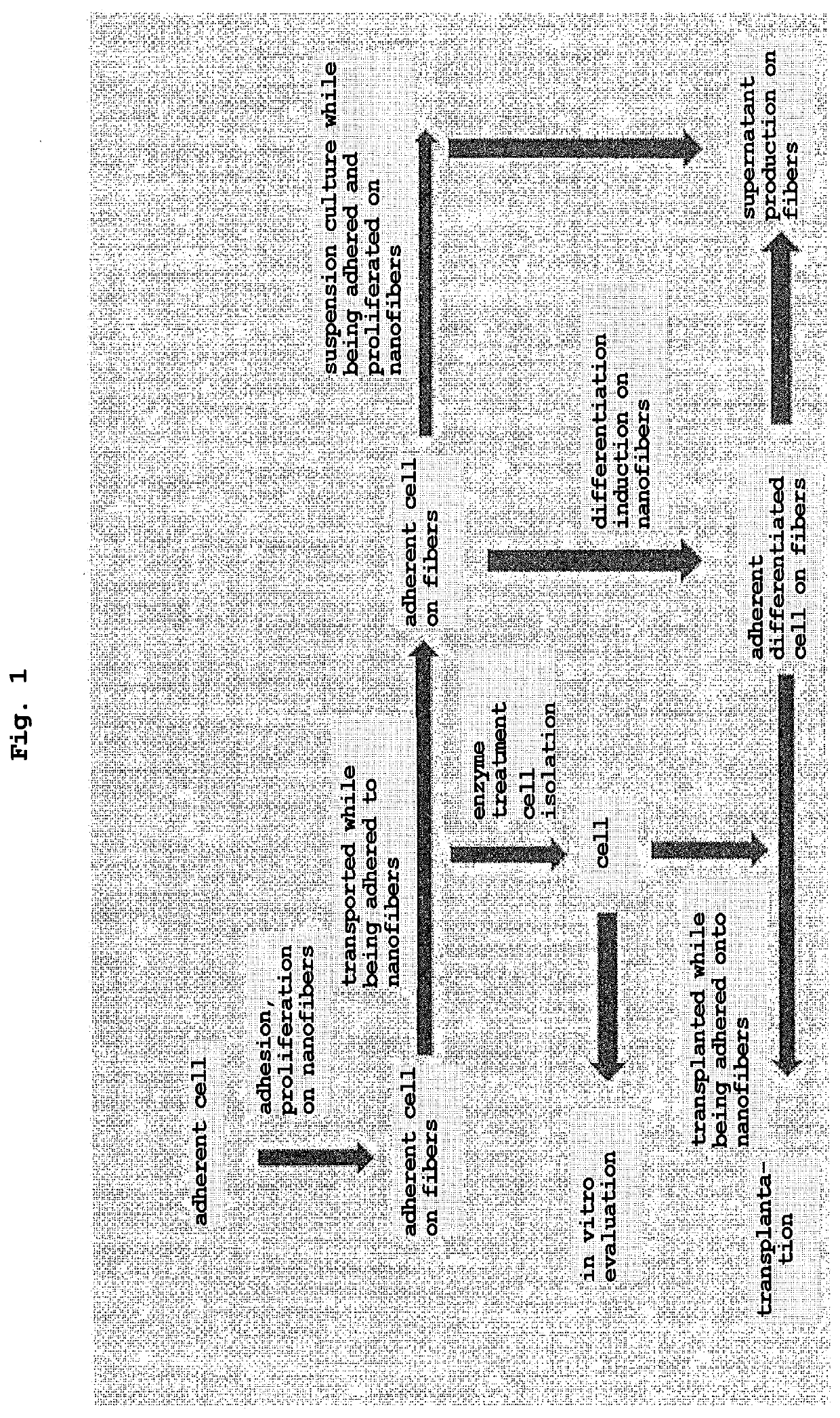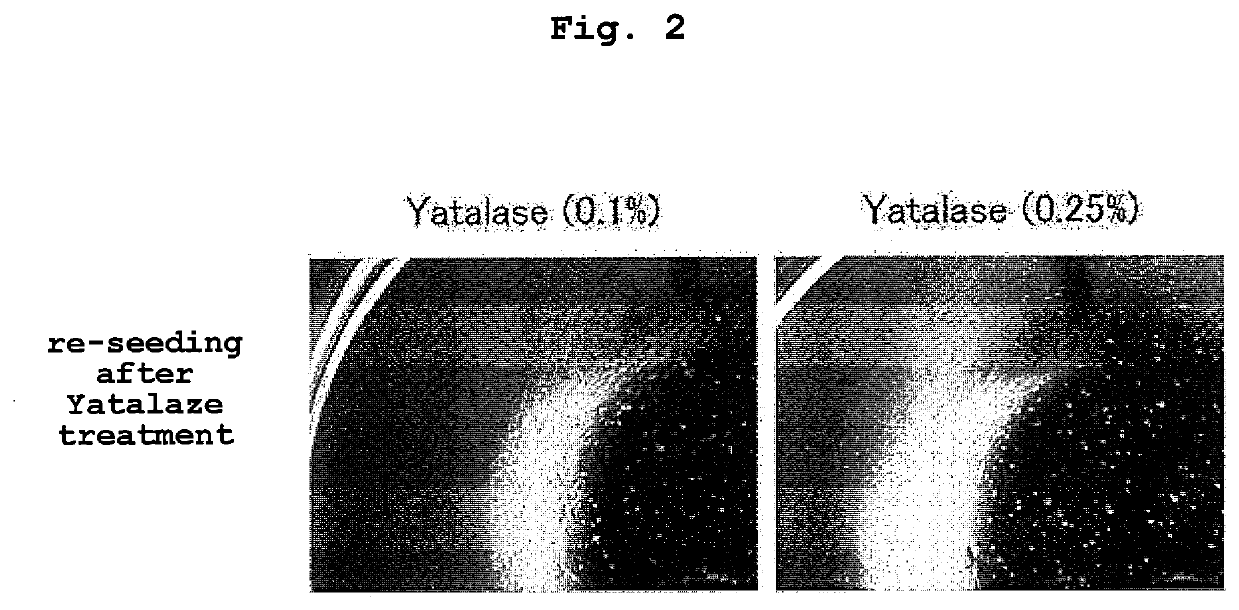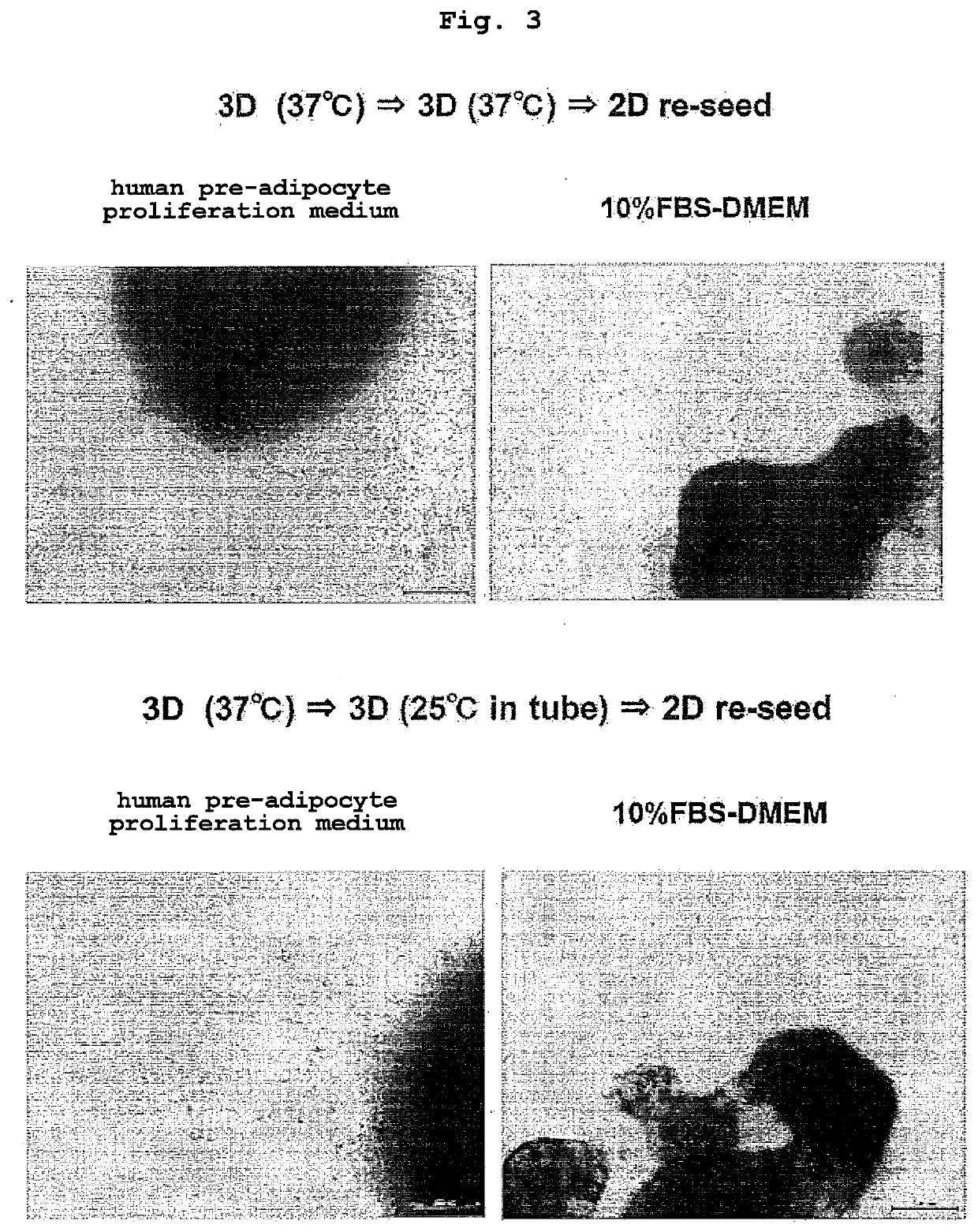Cell culturing using nanofibers
a technology of nanofibers and cells, applied in the field of nanofibers, can solve the problems of difficult to stably supply a large amount of cells in a suitable state for transplantation, high cost, and risk of tumorigenicity of ips cells, and achieves the effects of minimizing cell damage, easy removal, and good survivability
- Summary
- Abstract
- Description
- Claims
- Application Information
AI Technical Summary
Benefits of technology
Problems solved by technology
Method used
Image
Examples
experimental example 1
Pre-Adipocyte by 3D Culture Using Chitin Nanofiber
[0126]Chitin nanofiber (biomass nanofiber BiNFi-S 2 mass %, Sugino Machine Limited, Lot. GG30-G30) and deacylated gellan gum (DAG) (KELCOGEL CG-LA, manufactured by SANSHO Co., Ltd.) were each suspended in ultrapure water (Milli-Q water) to 1% (w / v) and dispersed by stirring with heating at 90° C., and the aqueous solution was autoclave sterilized at 121° C. for 20 min. A medium composition obtained by adding a chitin nanofiber to a human pre-adipocyte proliferation medium (# CAS11K500, manufactured by TOYOBO CO., LTD.) (final concentration: 0.003% (w / v), 0.01% (w / v), 0.03% (w / v)), a medium composition added with deacylated gellan gum (final concentration: 0.015% (w / v), 0.03% (w / v)), and a no-addition medium composition free of the above-mentioned substrate were prepared. Successively, the cultured human pre-adipocytes (derived from subcutaneous tissue, # CAS02s05a, manufactured by TOYOBO CO., LTD.) were suspended in each of the above...
experimental example 2
Adipose Tissue-Derived Mesenchymal Stem Cells by 3D Culture Using Chitin Nanofiber
[0128]Chitin nanofiber (biomass nanofiber BiNFi-S 2 mass %, Sugino Machine Limited, Lot. GG30-G30) was suspended in ultrapure water (Milli-Q water) to 1% (w / v), dispersed by stirring with heating at 90° C., and the aqueous solution was autoclave sterilized at 121° C. for 20 min. A medium composition obtained by adding a chitin nanofiber to a mesenchymal stem cell proliferation medium (C-28009, manufactured by Takara Bio Inc.) which is a low serum medium (final concentration: 0.001% (w / v), 0.003% (w / v), 0.01% (w / v), 0.03% (w / v)), and a no-addition medium composition free of the above-mentioned substrate were prepared. Successively, the cultured human adipose-derived mesenchymal stem cells (C-12977, manufactured by Takara Bio Inc.) were suspended in each of the above-mentioned medium compositions at 13333 cells / mL, and seeded in a 96 well flat bottom ultra low attachment surface microplate (manufactured ...
experimental example 3
Adipocytes Adhered to Chitin Nanofiber
[0130]Chitin nanofiber (biomass nanofiber BiNFi-S 2 mass %, Sugino Machine Limited, Lot. GG30-G30) was suspended in ultrapure water (Milli-Q water) to 1% (w / v), dispersed by stirring with heating at 90° C., and the aqueous solution was autoclave sterilized at 121° C. for 20 min. A medium composition obtained by adding a chitin nanofiber to a human pre-adipocyte proliferation medium (# CAS11K500, manufactured by TOYOBO CO., LTD.) (final concentration: 0.03% (w / v)) was prepared. Successively, the cultured human pre-adipocytes (derived from subcutaneous tissue, # CAS02s05a, manufactured by TOYOBO CO., LTD.) were suspended in the above-mentioned medium composition at 33333 cells / mL, and seeded in a 96 well flat bottom ultra low attachment surface microplate (manufactured by Corning Incorporated, #3474) at 150 μL / well. The cells were cultured in a CO2 incubator (37° C., 5% CO2) in a static state for 3 days, and the cells were adhered to the chitin na...
PUM
| Property | Measurement | Unit |
|---|---|---|
| diameter | aaaaa | aaaaa |
| diameter | aaaaa | aaaaa |
| diameter | aaaaa | aaaaa |
Abstract
Description
Claims
Application Information
 Login to View More
Login to View More - R&D
- Intellectual Property
- Life Sciences
- Materials
- Tech Scout
- Unparalleled Data Quality
- Higher Quality Content
- 60% Fewer Hallucinations
Browse by: Latest US Patents, China's latest patents, Technical Efficacy Thesaurus, Application Domain, Technology Topic, Popular Technical Reports.
© 2025 PatSnap. All rights reserved.Legal|Privacy policy|Modern Slavery Act Transparency Statement|Sitemap|About US| Contact US: help@patsnap.com



